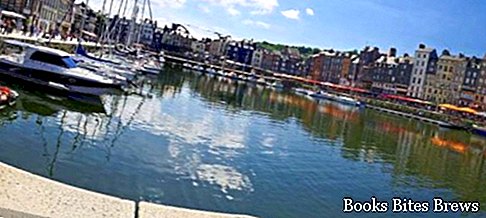What to see in Normandy, an itinerary including the main places of interest in this northern region of France, between undulating landscapes in the hinterland and cliffs alternating with sandy beaches along the coast, up to Mont Saint Michel.
Tourist information
Overlooking the English Channel, the territory of Normandy extends from east to west, starting from the western limit of the Paris Basin to Brittany.
The name derives from the Normans, who landed there in the ninth century AD.
From an administrative point of view, the region is divided into Lower Normandy with the capital Caen, and Upper Normandy with the capital Rouen.
The internal landscape of this region is characterized by undulating soils formed by cultivated fields bordered by hedges, rich in fruit trees and pasture meadows, which leave space for small scattered villages, as well as open and fertile flat countryside.
On the coast there are cliffs with dizzying heights and low sandy beaches, facing the sea regulated by the spectacular phenomenon of low and high tide.
These coasts are linked, from the historical point of view, to the great landing of the allied forces that took place at dawn on June 6, 1944, during the Second World War, and it is moving to find, in the most significant places where this important event took place, numerous testimonies who remember him.
We point out Omaha Beach, the village of Arromanches and that of Sainte-Mère-Église.
In Colleville-sur-Mer on the beach called Omaha Beach, there are the remains of the German fortifications, and monuments dedicated to the event.
The immense and evocative American cemetery stretches over it, a place that invites reflection.
In Arromanches you can visit the remains of the artificial harbor, the museum and in a small cinema you can watch a projection of a movie from the Second World War era, with an overview of the local places and events.
Recommended readings- Champagne Ardenne (France): what to see in the region
- Saint Tropez (France): what to see
- Burgundy (France): what to see in the region
- Lourdes (France): what to see where the Madonna appeared
- Picardy (France): what to see in the region
Sainte Mère Église, one of the first cities to be freed, is known for the story of the American paratrooper who got caught on the church bell tower, and pretended to be dead before being saved by his companions.
On the bell tower there is a mannequin that recalls this fact.
Also in this town there is a museum.
Close to the above mentioned beaches is Caen.
What see
Caen was largely destroyed during the Second World War and was later rebuilt. Many monuments were restored and, although few walls remained of many churches, the city retains a significant architectural heritage.
Among the noteworthy monuments are the Abbaye aux Hommes (Abbey of men), built by William the Conqueror in the 11th century, who also built the Castle.
The Abbaye aux Dames (Women's Abbey), built between 1060 and 1080 by Queen Matilde. The Mémorial pour la Paix, museum and international cultural center dedicated to peace.
Among the beautiful places to visit in Normandy, the Cote d'Albatre is very famous, extending for about 100 km from Dieppe to Etretat, known for its splendid landscape characterized by high and white cliffs overlooking the sea and narrow smooth pebble beaches , inspirational scenarios for great artists.
In Mont Saint-Michel, a village perched on a rocky island, there is a wonderful architectural complex, built between the 11th and 16th centuries, which was followed by restorations in later periods.
The beautiful Benedictine Abbey, dedicated to St. Michael the Archangel, and the village built in its shadow, dominate an immense expanse of sand and water exposed to the suggestive phenomenon of the tides.
The site is a Unesco World Heritage Site.
Honfleur is a small port and a picturesque seaside town, with narrow streets and characteristic old houses.
Bayeux, is the city famous for its extraordinary tapestry, also known as Queen Matilde's tapestry.
It is an embroidery of 70 meters in length made in the 11th century, which celebrates the conquest of England by William Duke of Normandy.
The canvas was most likely embroidered by monks in southern England after the battle of Hastings on October 14, 1066.
Rouen, famous for its cathedral, is located near the place where Joan of Arc was burned alive on May 30, 1431.
Notre-Dame de Rouen is one of the most beautiful and largest French Gothic churches.
The famous impressionist painter Claude Monet, represented a facade of this Cathedral at different times of the day, creating a series of paintings.
Speaking of Monet, in the town of Giverny there is the house with the gardens where Claude Monet lived and died, from 1883 to 1926.




